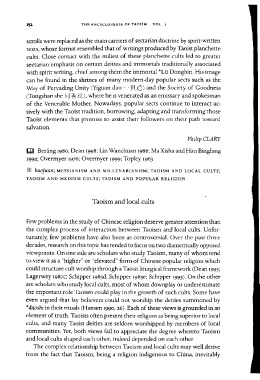Page 192 - The Encyclopedia of Taoism v1_A-L
P. 192
1520 THE ENCYCLOPEDIA OF TAOISM VOL. I
scrolls were replaced as the main carriers of sectarian doctrine by spirit-written
texts, whose format resembled that of writings produced by Taoist planchette
cults. Close contact with the milieu of these planchette cults led to greater
sectarian emphasis on certain deities and immortals traditionally associated
with spirit writing, chief among them the immortal *Lii Dongbin. His image
can be found in the shrines of many modern-day popular sects such as the
Way of Pervading Unity (Yiguan dao - . ~ ill) and the Society of Goodness
(Tongshan she I,;J~' in, where he is venerated as an emissary and spokesman
of the Venerable Mother. Nowadays, popular sects continue to interact ac-
tively with the Taoist tradition, borrowing, adapting and transforming those
Taoist elements that promise to assist their followers on their path toward
salvation.
Philip CLART
III Berling 1980; Dean 1998; Lin Wanchuan 1986; Ma Xisha and Han Bingfang
1992; Overmyer 1976; Overmyer 1999; Topley 1963
* baojuan; MESSIANISM AND MILLENARIANISM; TAOISM AND LOCAL CULTS;
TAOISM AND MEDIUM CULTS; TAOISM AND POPULAR RELIGION
Taoism and local cults
Few problems in the study of Chinese religion deserve greater attention than
the complex process of interaction between Taoism and local cults. Unfor-
tunately, few problems have also been as controversial. Over the past three
decades, research on this topic has tended to focus on two diametrically opposed
viewpoints. On one side are scholars who study Taoism, many of whom tend
to view it as a "higher" or "elevated" form of Chinese popular religion which
could structure cult worship through a Taoist liturgical framework (Dean 1993;
Lagerwey 1987C; Schipper 1985d; Schipper 1985e; Schipper 1993). On the other
are scholars who study local cults, most of whom downplay or underestimate
the important role Taoism could play in the growth of such cults. Some have
even argued that lay believers could not worship the deities summoned by
*daoshi in their rituals (Hansen 1990,26). Each of these views is grounded in an
element of truth. Taoists often present their religion as being superior to local
cults, and many Taoist deities are seldom worshipped by members of local
communities. Yet, both views fail to appreciate the degree whereto Taoism
and local cults shaped each other, indeed depended on each other.
The complex relationship between Taoism and local cults may well derive
from the fact that Taoism, being a religion indigenous to China, inevitably

